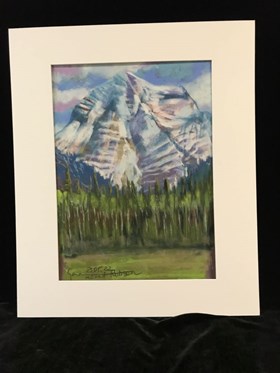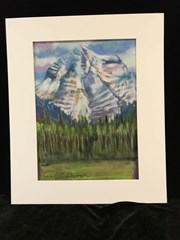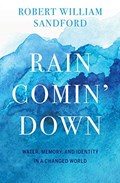Narrow Results By
Dark days at noon : the future of fire
https://archives.whyte.org/en/permalink/catalogue26239
- Medium
- Library - Book (including soft-cover and pamphlets)
- Published Date
- 2022
- Author
- Struzik, Edward
- Publisher
- Montreal ; Kingston ; London ; Chicago : McGill-Queen's University Press
- Call Number
- 04 St8d
- Author
- Struzik, Edward
- Publisher
- Montreal ; Kingston ; London ; Chicago : McGill-Queen's University Press
- Published Date
- 2022
- Physical Description
- ix, 291 pages : illustrations (chiefly colour), colour map ; 27 cm
- Abstract
- The catastrophic runaway wildfires advancing through North America and other parts of the world are not unprecedented. Fires loomed large once human activity began to warm the climate in the 1820s, leading to an aggressive firefighting strategy that has left many of the continent's forests too old and vulnerable to the fires that many tree species need to regenerate. Dark Days at Noon provides a broad history of wildfire in North America, from pre-European contact to the present, in the hopes that we may learn from how we managed fire in the past, and apply those lessons in the future. As people continue to move into forested landscapes to work, play, live, and ignite fires--intentionally or unintentionally--fire has begun to take its toll, burning entire towns, knocking out utilities, closing roads, and forcing the evacuation of hundreds of thousands of people. Fire management in North America requires attention and cooperation from both sides of the border, and many of the most significant fires have taken place at the boundary line. Despite a clear lack of political urgency among political leaders, Edward Struzik argues that wildfire science needs to guide the future of fire management, and that those same leaders need to shape public perception accordingly. By explaining how society's misguided response to fire has led to our current situation, Dark Days at Noon warns of what may happen in the future if we do not learn to live with fire as the continent's Indigenous Peoples once did. -- Provided by publisher.
- Contents
- Introduction -- 1. Prelude to the dark days at noon -- 2. The fire triangle -- 3. More dark days coming -- 4. The big burn -- 5. Big burns in Canada -- 6. Paiute forestry -- 7. Fire suppression -- 8. The Civilian Conservation Corps -- 9. Canada's Conservation Corps -- 10. The fall of the Dominion Forest Service -- 11. The royal commission into wildfire -- 12. White man's fire -- 13. International co-operation -- 14. Blue moon and blue sun -- 15. Nuclear winter -- 16. Yellowstone: A turning point -- 17. Big and small grizzlies -- 18. Climate and the age of megafire -- 19. The holy shit fire -- 20. The Pyrocene -- 21. Nuclear winter: Part two -- 22. Owls and clear-cuts -- 23. Water on fire -- 24. The Arctic on fire -- 25. The big smoke -- 26. Fire news -- Conclusion.
- ISBN
- 9780228012092
- Accession Number
- P2024.02
- Call Number
- 04 St8d
- Collection
- Archives Library
This material is presented as originally created; it may contain outdated cultural descriptions and
potentially offensive content.
Read more.
Hope matters : why changing the way we think is critical to solving the environmental crisis
https://archives.whyte.org/en/permalink/catalogue25274
- Medium
- Library - Book (including soft-cover and pamphlets)
- Published Date
- 2020
- Author
- Kelsey, Elin
- Publisher
- Vancouver ; Berkeley : Greystone Books
- Call Number
- 04 K27h
1 website
- Author
- Kelsey, Elin
- Responsibility
- Elin Kelsey
- Publisher
- Vancouver ; Berkeley : Greystone Books
- Published Date
- 2020
- Physical Description
- 229 pages
- Subjects
- Environment
- Conservation
- Climate change
- Abstract
- We are at an inflection point: today, more people than ever before recognize that climate change and biodiversity loss are urgent and existential threats. Yet constant reports of climate doom are fueling an epidemic of eco-anxiety, leaving many of us feeling hopeless and powerless—and hampering our ability to address the very real challenges we face. Hope Matters boldly breaks through the narrative of doom and gloom that has overtaken conversations about our future to show why hope, not fear, is our most powerful tool for tackling the planetary crisis. Award-winning author, scholar, and educator Elin Kelsey reveals the collateral damage of despair—from young people who honestly believe they have no future to the link between climate anxiety and hyper-consumerism—and argues that the catastrophic environmental news that dominates the media tells only part of the story. She describes effective campaigns to support ocean conservation, species resilience, and rewilding, demonstrating how digital conservation is helping scientists target specific problems with impressive results. And she shows how we can build on these positive trends and harness all our emotions about the changing environment—anger and sadness as well as hope—into effective personal and political action. Timely, evidence-based, and persuasive, Hope Matters is an argument for the place of hope in our lives and a celebration of the turn toward solutions in the face of the environmental crisis. (from publisher's website)
- Contents
- The power of expectation and belief -- The collateral damage of doom and gloom -- Hope is contagious -- Stories change -- The age of personalization -- We are not the only ones actively responding -- The strength of empathy, kindness, and compassion -- Trending hopeful.
- Notes
- Published in Partnership with the David Suzuki Institute.
- ISBN
- 9781771647779
- Accession Number
- P2020.07
- Call Number
- 04 K27h
- Collection
- Archives Library
- URL Notes
- Publisher's website
Websites
This material is presented as originally created; it may contain outdated cultural descriptions and
potentially offensive content.
Read more.
Ilira : the effects of climate change on the Arctic come into focus during the first human-powered attempt to transit the Northwest Passage
https://archives.whyte.org/en/permalink/catalogue15256
- Medium
- Library - Periodical
- Published Date
- 2014/2015
- Author
- Vallely, Kevin
- Publisher
- In Mountain Life Annual, 2014/2015
- Call Number
- P
- Author
- Vallely, Kevin
- Publisher
- In Mountain Life Annual, 2014/2015
- Published Date
- 2014/2015
- Physical Description
- p.28-39
- Medium
- Library - Periodical
- Subjects
- Arctic
- Climate change
- Northwest Passage
- Call Number
- P
- Collection
- Archives Library
This material is presented as originally created; it may contain outdated cultural descriptions and
potentially offensive content.
Read more.
Innovate : the Mountain Legacy Project
https://archives.whyte.org/en/permalink/catalogue25006
- Medium
- Library - Periodical
- Published Date
- 2019/2020
- Author
- Anthony, Leslie
- Call Number
- P
1 website
- Author
- Anthony, Leslie
- Published Date
- 2019/2020
- Medium
- Library - Periodical
- Subjects
- Mountains
- Photography
- Climate
- Climate change
- Glaciers
- Abstract
- Pertains the the Mountain Legacy project and their use of repeat photography and historic photographs to chart changes in climate in the Canadian Rocky Mountains
- Notes
- In Mountain Life Annual, 2019/2020, pg. 42 - 43
- Call Number
- P
- Collection
- Archives Library
- URL Notes
- Mountain Life Annual website
Websites
This material is presented as originally created; it may contain outdated cultural descriptions and
potentially offensive content.
Read more.
- Artist
- Gennadiy Ivanov
- Date
- ca. 2022 – 2022
- Medium
- pastel on paper
- Catalogue Number
- IvG.03.04
- Description
- Landscape drawing of Mount Robson composed of a colour palette of varying of blues, purples, white and brown. The background has a blue sky, with clouds rendered in white and purple. The focal point is the large mountain decorated with white, purple and brown vertical lines. The middle ground us a …
1 image
- Artist
- Gennadiy Ivanov
- Title
- Mount Robson
- Date
- ca. 2022 – 2022
- Medium
- pastel on paper
- Dimensions
- 49.0 x 35.0 cm
- Description
- Landscape drawing of Mount Robson composed of a colour palette of varying of blues, purples, white and brown. The background has a blue sky, with clouds rendered in white and purple. The focal point is the large mountain decorated with white, purple and brown vertical lines. The middle ground us a forest of green trees, and the foreground is a flat area of green grass.
- Credit
- Gift of Gennadiy Ivanov, Norwich, Norfolk , UK, 2023
- Catalogue Number
- IvG.03.04
Images
This material is presented as originally created; it may contain outdated cultural descriptions and
potentially offensive content.
Read more.
Mountain state : Canada's mountains are its watertowers, critical habitat and, researchers say, its climate-change sentinels
https://archives.whyte.org/en/permalink/catalogue119
- Medium
- Library - Periodical
- Author
- Walker, Nick
- Publisher
- Canadian Geographic
- Call Number
- P
- Author
- Walker, Nick
- Publisher
- Canadian Geographic
- Medium
- Library - Periodical
- Subjects
- Rocky Mountains
- Climate change
- Notes
- In Canadian Geographic, May-June 2018 2018, p. 28-29
- Call Number
- P
- Collection
- Archives Library
This material is presented as originally created; it may contain outdated cultural descriptions and
potentially offensive content.
Read more.
On the rocks : the local impacts of glacial melt
https://archives.whyte.org/en/permalink/catalogue20030
- Medium
- Library - Periodical
- Published Date
- 2015
- Author
- Payne, Colin
- Call Number
- P
1 website
- Author
- Payne, Colin
- Responsibility
- Colin Payne
- Published Date
- 2015
- Medium
- Library - Periodical
- Abstract
- Pertains to the de-glaciation of Western Canada during the 21st century with the Athabasca Glacier as the example
- Notes
- In Highline Magazine, Iss. 16, Fall 2015, p. 40 - 45
- Call Number
- P
- Collection
- Archives Library
- URL Notes
- Highline website
Websites
This material is presented as originally created; it may contain outdated cultural descriptions and
potentially offensive content.
Read more.
Our vanishing glaciers : the snows of yesteryear and the future climate of the mountain West
https://archives.whyte.org/en/permalink/catalogue25256
- Medium
- Library - Book (including soft-cover and pamphlets)
- Published Date
- 2017
- Author
- Sandford, Robert W.
- Publisher
- [Victoria, British Columbia] : Rocky Mountain Books
- Edition
- First
- Call Number
- 03.4 Sa5o
1 website
- Author
- Sandford, Robert W.
- Responsibility
- Robert W. Sandford
- Edition
- First
- Publisher
- [Victoria, British Columbia] : Rocky Mountain Books
- Published Date
- 2017
- Physical Description
- 223 pages : illustrations (chiefly color), maps (chiefly color)
- Subjects
- Water
- Watersheds
- Rivers
- Glaciers
- Hydrology
- Hydrology - Alberta
- Rocky Mountains
- Climate change
- Abstract
- Written by one of the most respected experts in water and water-associated climate science and featuring stunning photography collected over the past four decades, Our Vanishing Glaciers explains and illustrates why water is such a unique substance and how it makes life on this planet possible. Focusing on the Columbia Icefield, the largest and most accessible mass of ice straddling the Continental Divide in western North America, and featuring photographs, illustrations, aerial surveys and thermal imaging collected over more than 40 years of the author’s personal observations, the book reveals the stunning magnitude of glacial ice in western Canada. Citing evidence to suggest that in the Canadian Rocky Mountain national parks alone, as many as 300 glaciers may have disappeared since 1920, this large-format, fully illustrated coffee table book graphically illustrates the projected rate of glacier recession in the mountain West over the rest of this century and serves as a profound testament to the beauty and importance of western Canada’s water, ice and snow. (from publisher's website)
- Contents
- 1. The wonder of water -- 2. What winter does to water -- 3. Ecology as defined by winter water -- 4. How ice fields and glaciers form -- 5. Canada's most accessible glaciers -- 6. The death of Peyto glacier : A case for more comprehensive -- 7. The Columbia ice field today -- 8. Glaciers in a changing climate -- 9. What we stand to lose -- 10. Water, climate and the National Parks ideal.
- Notes
- Winner, 2017 Lane Anderson Award for Best Canadian Science Writing
- ISBN
- 9781771602020
- Accession Number
- P2020.07
- Call Number
- 03.4 Sa5o
- Location
- Reading Room
- Collection
- Archives Library
- URL Notes
- Publisher's website
Websites
This material is presented as originally created; it may contain outdated cultural descriptions and
potentially offensive content.
Read more.
Peyto : a hotbed of glacier science
https://archives.whyte.org/en/permalink/catalogue19950
- Medium
- Library - Periodical
- Published Date
- 2012
- Author
- Martel, Lynn
- Call Number
- P
1 website
- Author
- Martel, Lynn
- Responsibility
- Lynn Martel
- Published Date
- 2012
- Medium
- Library - Periodical
- Abstract
- Pertians to Peyto Glacier and glacier monitoring programs through Natural Resources Canada
- Notes
- In Highline Magazine, Vol.4, Iss.1, Winter 2012, p.36-41
- Call Number
- P
- Collection
- Archives Library
- URL Notes
- Highline website
Websites
This material is presented as originally created; it may contain outdated cultural descriptions and
potentially offensive content.
Read more.
Rain comin' down : water, memory and identity in a changed world
https://archives.whyte.org/en/permalink/catalogue25257
- Medium
- Library - Book (including soft-cover and pamphlets)
- Published Date
- 2019
- Author
- Sandford, Robert W.
- Publisher
- [Victoria, British Columbia] : Rocky Mountain Books
- Edition
- First
- Call Number
- 03.5 Sa5r
1 website
- Author
- Sandford, Robert W.
- Responsibility
- Robert W. Sandford
- Edition
- First
- Publisher
- [Victoria, British Columbia] : Rocky Mountain Books
- Published Date
- 2019
- Physical Description
- 330 pages
- Subjects
- Water
- Watersheds
- Rivers
- Glaciers
- Hydrology
- Hydrology - Alberta
- Rocky Mountains
- Climate change
- Abstract
- Robert Sandford has spent a lot time watching and thinking about water. This was not because he was predisposed to do so, but because the importance of water gradually caught up with who he was and what he was doing with his life. As this self-reflective book demonstrates, when one takes up the serious study of water, one cannot but be surprised at how far that interest can take you: from the very origins of the cosmos right down to the unique structure and remarkable qualities of water as a molecule. It takes you to the depths of the oceans, to the upper reaches of the Earth’s atmosphere, and into the centres of storms. You fall to Earth with raindrops, travel tiny streams and great rivers, go round and round in lakes and ponds. Your study takes you down to the very roots of trees, into the soil, along the dark, dank banks of underground rivers. It takes you from one person’s thirst to the thirst of nations; from the demographics of the past to how those may drastically change in the absence of water in decades to come. Following water takes one back and forth in time, linking us to what the Earth was like in the past; what it is now; and how water will shape what it will be in the future. (from publisher's website)
- Contents
- Invocation - Rain comin' down
- Celestial rivers
- Rivers of cold
- Rivers of heat
- Rivers of words
- The heart of dryness
- Irrigating Eden
- Rivers of memory
- Rivers of ice
- As the world burns
- Learning from the burning: The summer of 2018
- Afterword - Rivers of hope
- Appendix - a Canadian National Glacier Act
- Bookshelf
- ISBN
- 9781771603171
- Accession Number
- P2020.07
- Call Number
- 03.5 Sa5r
- Collection
- Archives Library
- URL Notes
- Publisher's website
Websites
This material is presented as originally created; it may contain outdated cultural descriptions and
potentially offensive content.
Read more.






